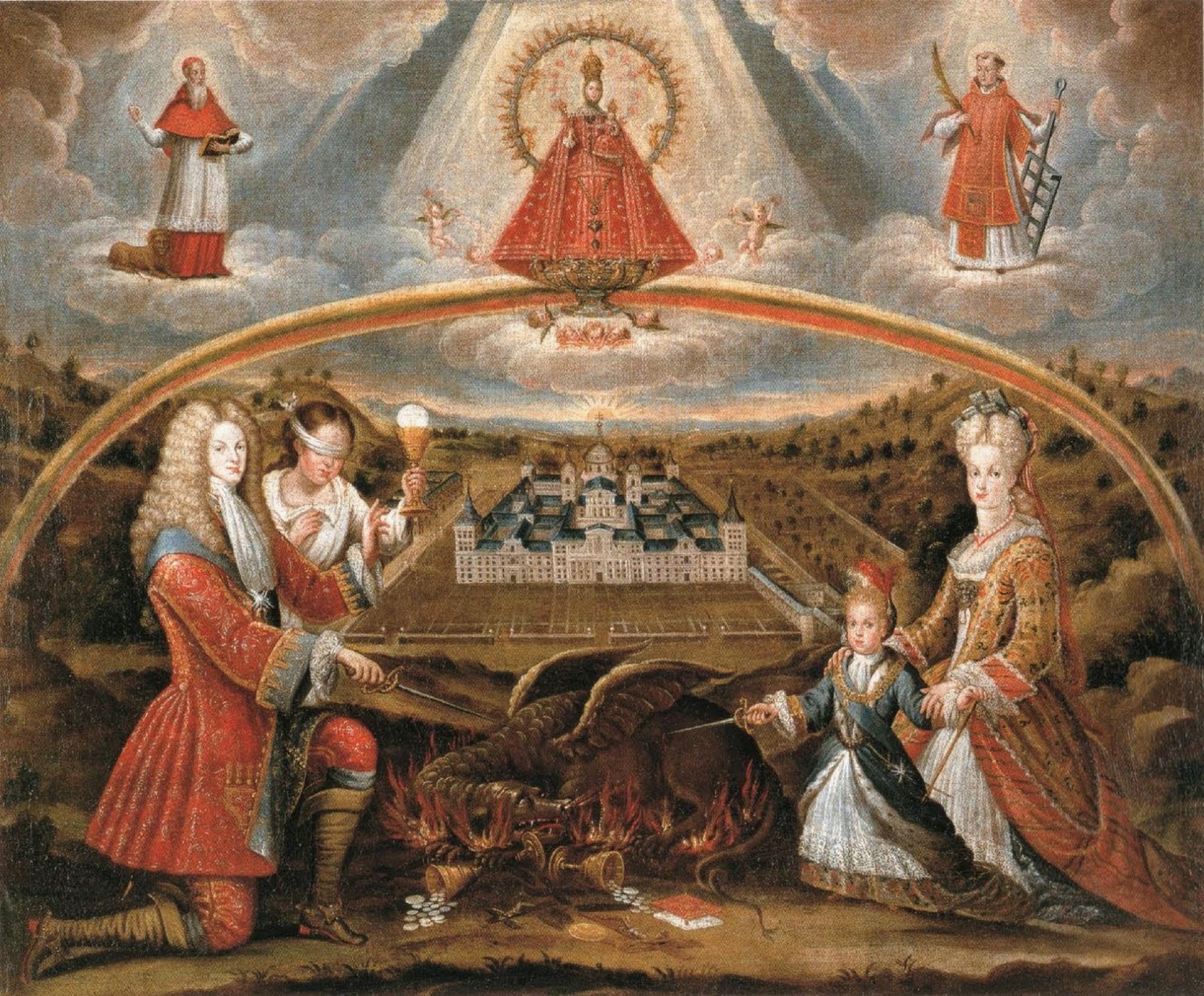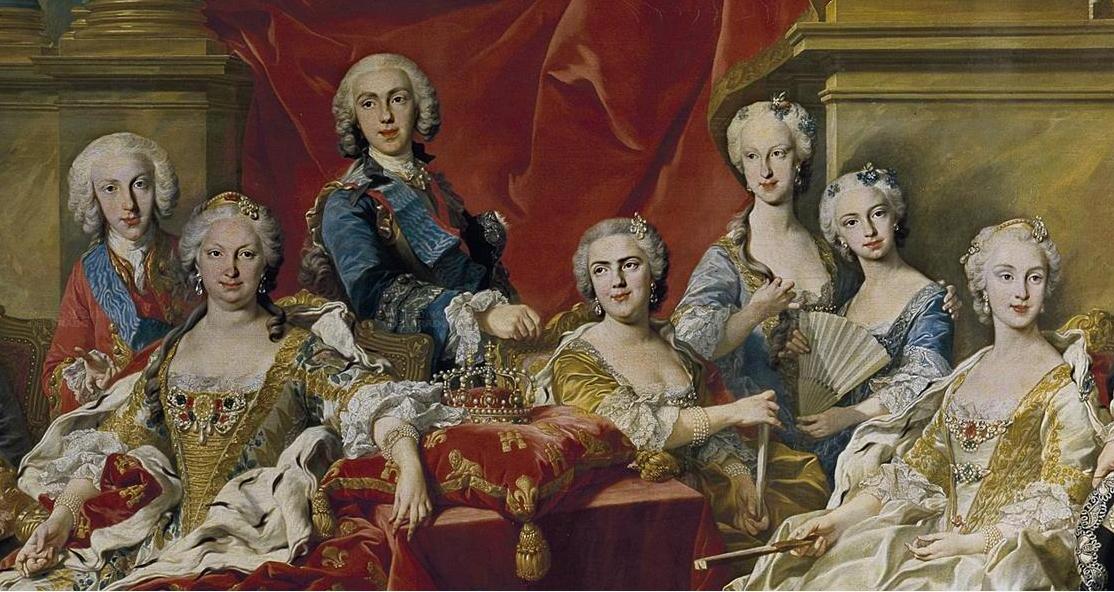
Felipe V defeating Heresy, National Heritage, Monastery of El Escorial. Photo by Felipe de Silva- Wikimedia commons
Top 10 Remarkable Facts about Philip V of Spain
Philip V, also known as (until 1700) Philippe, was the King of Spain from 1700 (apart from a relatively short time from January to August 1724) and the pioneer of the Bourbon empire in Spain. During his time in power, Spain recovered much of its former influence on the world stage.
1.His early upbringing and family background
Philip was born on December 19, 1683, at the Palace of Versailles in France, the second son of Louis, Grand Dauphin, France’s likely successor, and his wife Maria Anna Victoria of Bavaria, widely recognized as the Dauphine Victoire. His father was the eldest son of France’s Louis XIV and Spain’s Maria Theresa.
Philip was the younger brother of Louis, Duke of Burgundy, the father of France’s Louis XV. Philip was named Duke of Anjou at birth, a classical title for younger sons in the French royal family. Until he became King of Spain, he was recognized by this name. As Philip’s older brother, the Duke of Burgundy, was second in line to the French throne after his father, neither he nor his younger brother Charles, Duke of Berry, were expected to rule over France.
2.Philip reigned the nation through tough times
During Philip’s first 13 years in power, France had a substantial impact on the Spanish court, and the French ambassador was appointed to the inner council of state. After the death of his first wife, Maria Luisa of Savoy, in 1714, Philip was swayed by his second wife, Princess Isabella Farnese, the duke of Parma’s niece and stepdaughter.
Spain became engaged in dispute with Austria, Great Britain, France, and the United Provinces as a result of Isabella’s wish to protect regions in Italy for her sons however, was able to obtain the succession of Philip and Isabella’s oldest son, Don Carlos (later Charles III of Spain), to the duchy of Parma.
Philip resigned from the Spanish seat of power in January 1724 in favor of his eldest son, Luis however, was convinced to return when Luis died of smallpox in August 1724. Philip’s kingship is remembered mainly for the political and economic changes implemented by his French and Italian consultants.
3.Philip successfully made major changes to improve the economy

Detail of the 1743 portrait of the Family of Philip V of Spain, (Luis Antonio, Queen Elisabeth, Infante Felipe, Princess Louise Élisabeth, María Teresa Rafaela, María Antonia Fernanda and Queen Maria Amalia). Photo by Louis-Michel van Loo- Wikimedia commons
Now that the war was over and his statements to Spain and the Spanish Empire were secure, Philip set about reinforcing the dynasty and instituting the policy changes required for the kingdom’s economic expansion. Philip achieved a lot with the help of capable ministers like the Frenchman Jean Orry and the Spaniards Melchor de Macanaz and José Patio.
Orry progressively rebuilt the royal household in the French style and started the monumental task of economic liberalization. All whilst, Patio was expanding the country’s navy and instituting much-needed military policy changes. Roads and canals were constructed, and international tradesmen and engineers were brought to Spain.
On the eve of his death, Philip V could boast of an army that had exonerated national honor in war, a naval army that had reignited Europe’s interest and numerous foundations that indicated the rejuvenation of industry, trade and the arts.
4.Spain once declared bankruptcy
During the War of the Polish Succession and the War of the Austrian Succession, Philip assisted his Bourbon relatives in retaking Oran from the Ottomans and Naples and Sicily from Austria. During the War of Jenkins’ Ear (1739-1748), Spanish forces excelled in protecting their American territories from British invasion.
Although Spain began to rebuild during Philip’s reign, he enlisted large numbers of high earning staff to look after the royal family while the military and hierarchy of the kingdom went months without wages. The shipments of silver from the New World were the only thing that kept the nation alive and well. When it cancelled outstanding debts in 1739, Spain successfully went into bankruptcy.
5.Philip’s romantic relationships and children throughout his reign
Philip V married Maria Luisa of Savoy, the 13-year-old daughter of Victor Amadeus II, Duke of Savoy. Their proxy wedding took place on September 12, 1701, and their official wedding took place on November 2, the same year. Maria acted as ruler in her husband’s absence on several instances, most prominently when Philip was cruising his Italian areas in 1702.
During the War of the Spanish Succession, she also served as a political adviser. On February 14, 1714, the well-loved Queen of Spain died of tuberculosis. Louis I of Spain, Philip, Infante Philip of Spain, and Ferdinand VI of Spain were the couple’s four sons.
Philip married Elisabeth of Parma, daughter of Hereditary Prince of Parma Odoardo Farnese, by proxy on September 16, 1714. She had a massive impact on Spanish international relations and was de facto ruler of the kingdom from 1714 to 1746.
Charles III of Spain, Infanta Mariana Victoria of Spain, Infante Philip of Spain, Infanta Maria Teresa of Spain, Infante Louis of Spain, and Infanta Maria Antonia of Spain were Philip and Elisabeth’s six children.
6.His time ruling the kingdom made him a little crazy, literally!

The new born son of Philip V of Spain being held by his mother Marie Louise of Savoy, born Madrid 25 August 1707. Engraving, 1707. Photo by Marie Louis- Wikimedia commons
Philip had few close friends and was primarily interested in religion, scavenging and music. During the final years of his reign, he frequently drifted into lunacy, and his wife ultimately influenced government relations.
7.There is a portrait of Philip in the local museum in Spain
Over the previous half-century, the economy improved overall, with higher productivity and very few food shortages and disease outbreaks. The government encouraged the development of industry, agriculture, and shipbuilding. The navy was reconstructed after the destruction of the main silver fleet at Vigo in 1702. Nonetheless, the new fleet was still insufficient to support the vast global empire.
The portrait of the ruler hangs inverted in the local museum of L’Almod to commemorate the humiliations suffered by the city of Xàtiva following Philip’s victory in the Battle of Almansa in the War of the Spanish Succession, in which he instructed the city to be set on fire and renamed San Felipe.
8.Philip has an area in United States named after him
In 1716, the province of the New Philippines, which included parts of what is now Texas in the United States, was named after Philip.
Philip V supported and promoted Spain’s Atlantic trade with its American possessions. During this Atlantic trade, prominent people in Spanish maritime history resurfaced, including the corsair Amaro Pargo. Philip V commonly aided the corsair in his commercial incursions and corsairs: in September 1714, he granted a Royal order given at the Royal Palace of El Pardo in Madrid, appointing him captain of a commercial ship bound for Caracas.
9.His unfortunate death due to mental health issues
Philip suffered from manic depression and eventually succumbed to deep melancholia. Elizabeth Farnese, his second wife, extremely influenced her passive husband. She had more sons for him, along with another heir, Charles III of Spain. The start of August 1737, the castrato singer Farinelli, who became the “Musico de Camara of Their Majesties,” helped to alleviate his mental illness. Every night, Farinelli would perform eight or nine songs for the king and queen, typically with a group of singers.
Philip died in El Escorial, Madrid, on July 9, 1746 however, was laid to rest in his favorite Royal Palace of La Granja de San Ildefonso, near Segovia. He was succeeded by Ferdinand VI of Spain, his son by his first queen, Maria Luisa of Savoy.
10.Philip deserves much more credit for what he did for Spain

The children of Felipe V of Spain. Photo by Songsblame- Wikimedia commons
Historians have been harsh on the king in general. According to Lynch, Philip V progressed the government only slightly more than his successors and was a greater liability than Charles II. When the interests of Spain and France clashed, he usually sided with France. Philip did, but institute some national policies and enhance the elected governments in relation to the regions. Achievement became more crucial, though the ruling elite still held the majority of higher positions. Under the wealthy, the ineffectiveness and corruption that existed under Charles II were as prevalent as ever. Philip V’s policy changes ultimately resulted in the much more significant changes of Charles III.
Planning a trip to Paris ? Get ready !
These are Amazon’s best-selling travel products that you may need for coming to Paris.
Bookstore
- The best travel book : Rick Steves – Paris 2023 – Learn more here
- Fodor’s Paris 2024 – Learn more here
Travel Gear
- Venture Pal Lightweight Backpack – Learn more here
- Samsonite Winfield 2 28″ Luggage – Learn more here
- Swig Savvy’s Stainless Steel Insulated Water Bottle – Learn more here
Check Amazon’s best-seller list for the most popular travel accessories. We sometimes read this list just to find out what new travel products people are buying.










